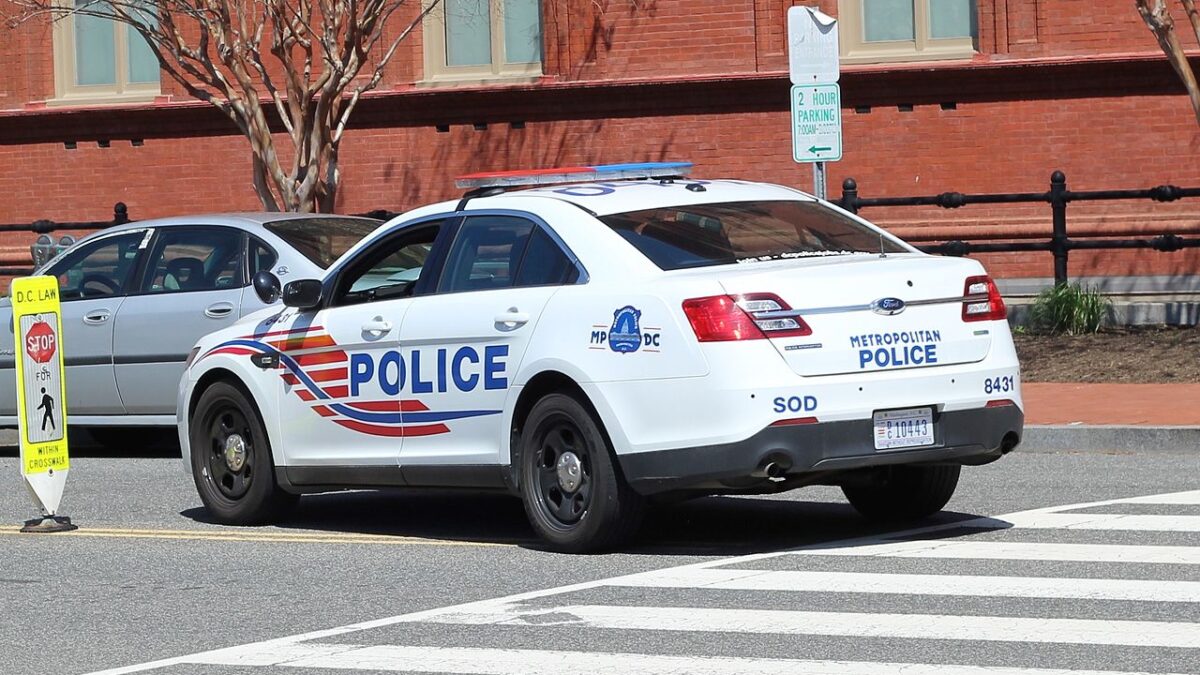
Proponents of defunding or disbanding police departments are lauding Camden, New Jersey, as a model for the nation. They suggest that the rapid decline in the city’s crime since it disbanded its police department in 2012 proves the merits of their position.
We can discern the truth by analyzing the policies Camden implemented after it disbanded its police department and measuring how well they worked.
It bears noting up front that in spite of the heartening declines in crime rates Camden has achieved since 2012, it remains one of the most dangerous cities in America. Its violent crime rate in 2019 was eight times that of New Jersey’s overall rate of violent crime, the highest rate by far of any city in a state with several high-crime urban centers. Yet this qualifies as progress. Last year marked the lowest-crime year in Camden in decades.
Proudly labeling Camden’s transformation as the result of disbanding its police force would be to tell less than half the story. Rather, Camden reorganized and grew its police force.
Camden Didn’t Exactly ‘Defund the Police’
In 2012, facing spiraling crime rates and fiscal strains stemming in part from its unionized police force, Camden dissolved its force to replace it with a then-nonunionized county police force that, as described in a 2014 Governing exposè, “rehired most of the laid-off cops, along with nearly 100 other officers, but at much lower salaries and with fewer benefits than they had received from the city.” Camden’s “disbanding” can really be thought of as a technical transition from a city to a county police department.
In 2011, amid budget cuts, Camden’s police force had reportedly dwindled to 175 officers, charged with protecting a city of more than 75,000. As few as 12 cops were on patrol at times. Subsequent to the reorganization, Camden had more than 400 officers, providing it one of the highest police presences on a per-capita basis of any large U.S. city.
Camden neither disbanded its police force, nor did it defund it. On the contrary, as Camden County Police Chief Joe Wysocki recently told Tapinto Camden: “As far as the change that has taken place, the number one difference is resources.”
Indeed, the Camden County Police Department (CCPD) has received ample resources, including tens of millions of dollars per year. According to the Philadelphia Inquirer, from the time the CCPD emerged, it received substantially more funds than originally budgeted. Its budget has only grown, today costing more than $68 million per year. By contrast, Paterson, another high-crime New Jersey city with a population nearly double Camden’s, estimates its annual police budget at $45 million.
Camden has used the funding not just to beef up the police force, but to equip it with sophisticated crime-fighting technology. As Matt Taibbi detailed in a December 2013 feature for Rolling Stone, Camden installed a massive surveillance apparatus, replete with more than 100 high-tech cameras covering the entire city, a mobile 30-foot patrol crane, dozens of microphones for identifying gunshot locations to within a few meters and pointing cameras to escape routes, and “Minority Report-style” scanners for reading license plates and generating warnings. Even civilians work as crime analysts to “patrol” the city virtually and direct uniformed officers from a robust command center.
In short, Camden today has more police — including many of its original officers — who operate using pervasive surveillance equipment likely to give civil libertarians pause. Moreover, presumably contrary to the desires of the defunders, the force consists of a significantly smaller percentage of minority police than did its predecessor.
Camden Police Haven’t Been Without Incident
Defunders will likely chafe at the suggestion that the policies chronicled above comport with their vision of policing. They will, however, point positively to Camden’s policy reforms. Camden has embraced the concept of “community policing.” This includes more cops walking the beat and interacting regularly with Camden residents, as well as far more restrictive use-of-force guidelines and de-escalatory training. In recent days, numerous profiles have covered these policing practices favorably. Evidence is thus far inconclusive as to the effectiveness of such policies in reducing crime.
While the city claims its policies have led to a dramatic reduction in complaints, from a state-high 65 in 2012 to three in 2019, the force has been implicated in alleged malfeasance. One particularly gruesome case is now pending against Camden County and several officers over a 2014 arrest that resulted in Xavier Ingram being rendered a quadriplegic.
Police pursued Ingram over suspicion that he had ditched a gun after departing from a group the police believed to be engaged in drug activity. The police chased Ingram, and he fell. In spite of claims that he was not resisting, police subdued him — allegedly with enough force to break his neck. Ingram was charged on gun possession and drug charges, which his lawyers dispute.
Discovery in Ingram’s lawsuit showed that during an 18-month period from 2013-2014, Camden dismissed practically every complaint against the CCPD, including virtually all of the 100-plus use-of-force complaints, while department-issued complaints were regularly sustained.
To be clear, anecdotal examples of alleged abuses of power, including this pending case, and complaint statistics are not dispositive in judging a police department. But the defunders might well do so on this basis, were they aware of such evidence.
Meanwhile, it would seem the city has also embraced policies that might be more aptly described as “broken windows” policing, again likely to the chagrin of defunders. The American Civil Liberties Union has previously criticized the CCPD for increasing enforcement of low-level offenses. The city has also spent millions of dollars razing hundreds of blighted buildings that often served as hubs of criminal activity.
Camden has likely benefited over time from criminal incarceration and the deterrence that follows from improved policing. Camden’s reforms also come against a backdrop of economic growth and improved educational outcomes.
What Do the Statistics Say?
What has happened to Camden’s crime rates since the reorganization of its police department?
It is undeniable that Camden has witnessed a significant reduction in both overall and violent crime between 2013 when the CCPD came on the beat, and 2019. A CCPD-provided crime report obtained by the author shows that during this period, Camden experienced a 38 percent drop in overall crime and a 40 percent drop in violent crime.
These numbers, on their face, are significant. But with such data, we must always ask, “Compared to what?” To evaluate the strides made by the CCPD, one must weigh its change in crime rates against those of the state in which it is situated, and cities similarly riddled with crime.
To make these comparisons, the author conducted a preliminary analysis based on New Jersey’s uniform crime reports, which are consistent with the numbers reported in the FBI uniform crime reports, but differ slightly from the CCPD’s (this may have occurred due to the CCPD’s reclassification of crimes and other factors).
Since New Jersey published only quarterly data for 2019 and the FBI has not published corresponding final data for that year, and because Camden’s greatest decline in crime since the reorganization of its police unit in 2013 occurred during 2018, it is most appropriate to look at 2013-2018 crime rates 1) statewide, 2) for Camden, and 3) among the five other cities New Jersey has historically classified as its “major urban” centers: Elizabeth, Jersey City, Newark, Paterson, and Trenton. These have typically been among the highest-crime areas in the state.
What are the findings? Between 2013 and 2018, New Jersey experienced a 25 percent reduction in overall crime and a 27 percent drop in violent crime. Camden experienced a 32 percent reduction in overall crime and 35 percent drop in violent crime.
Beating the state average is a good start. But was Camden the best performer of its peer group? No.
Newark experienced a 45 percent reduction in both overall crime and violent crime during this period. Interestingly, there has been no such clamoring for police across the nation to emulate the Newark Police Department. So too, Paterson and Jersey City each experienced declines in violent crime within 4 percent of Camden’s, albeit with smaller reductions in overall crime.
While the defunders are squarely focused on the CCPD’s performance post-2012, it is also clarifying to look at crime statistics over a longer period. Between 2000 and 2018, New Jersey experienced a 48 percent reduction in overall crime and a 44 percent reduction in violent crime. Camden’s overall crime rate fell by 43 percent and its violent crime rate by only 22 percent. That is, it lagged behind the rest of the state’s improvements, particularly regarding violent crime. It also lagged behind several of its peers. Newark, Jersey City, and Trenton all experienced greater reductions than Camden in both overall and violent crime during this period.
Don’t Jump to Conclusions
Two points ought to be made here. First, New Jersey in general and its cities in particular have followed the overall national trend of declining violent crime that we have been blessed to enjoy in America at a pronounced rate since the 1990s. This trend was the result of policies that defunders seem willing to toss out overnight, irrespective of their benefits to societal peace and prosperity.
Second, Camden’s more recent gains may reflect a catching up of sorts to its peers, though again, the relatively superior performance of Newark is striking. No two cities are alike, and we ought to be careful in drawing conclusions over relatively short time periods. But those heralding Camden’s policies as a panacea ought to consider the full context.
A prudent analysis must factor in not just the disbanding of the department, or its shift to community policing, but the increasing number of cops on the streets, the equipping of the police force with better tools, the residual effects of removing violent criminals from the streets over time, the potential deterrent effect of its superior police force, economic growth, and educational improvements, to name just a few factors. It must also consider crime reductions on a relative basis to determine if Camden has found the “secret sauce” of policing.
After conducting such an analysis, to the extent it holds true that Camden has implemented reforms that have uniquely reduced crime, its policies should be adopted wholeheartedly. But we should be skeptical of claims not grounded in rigorous analysis, particularly in the throes of tumult.









